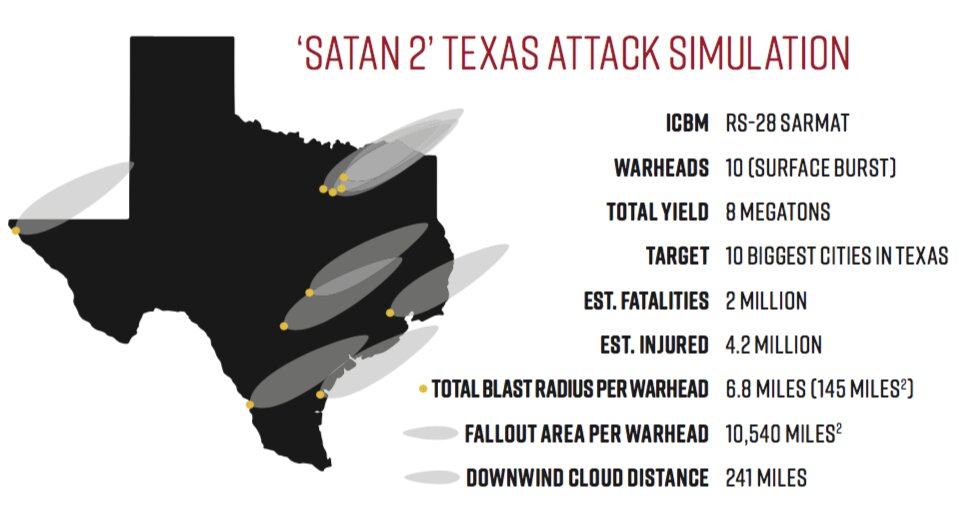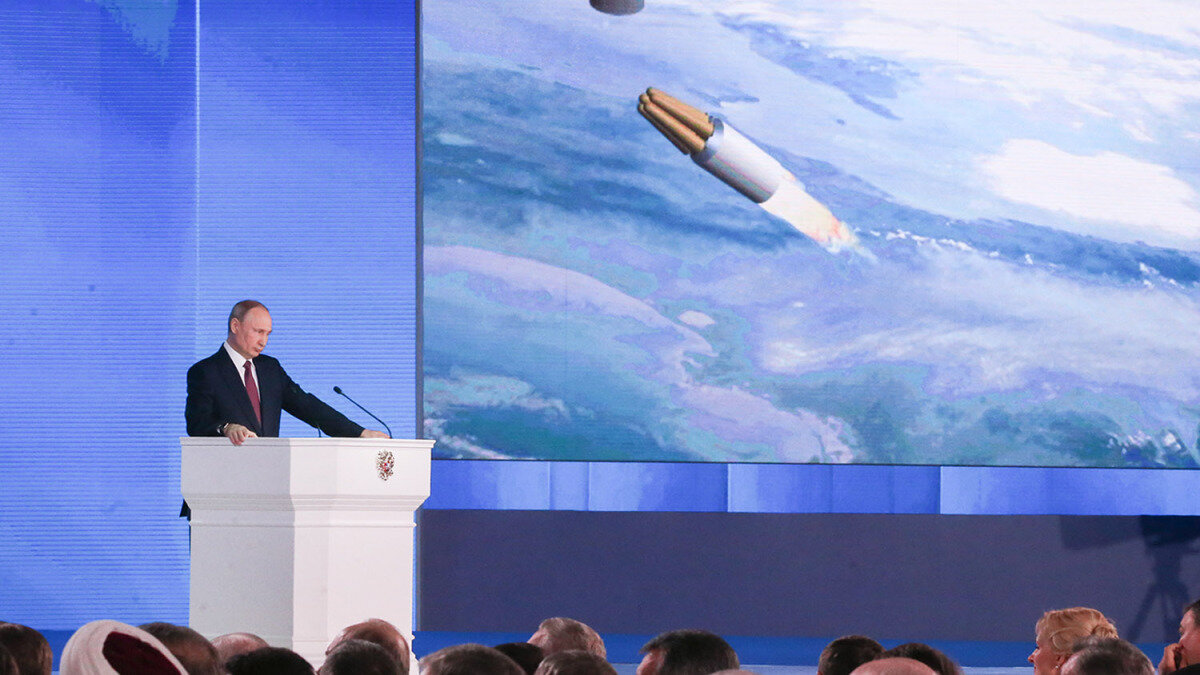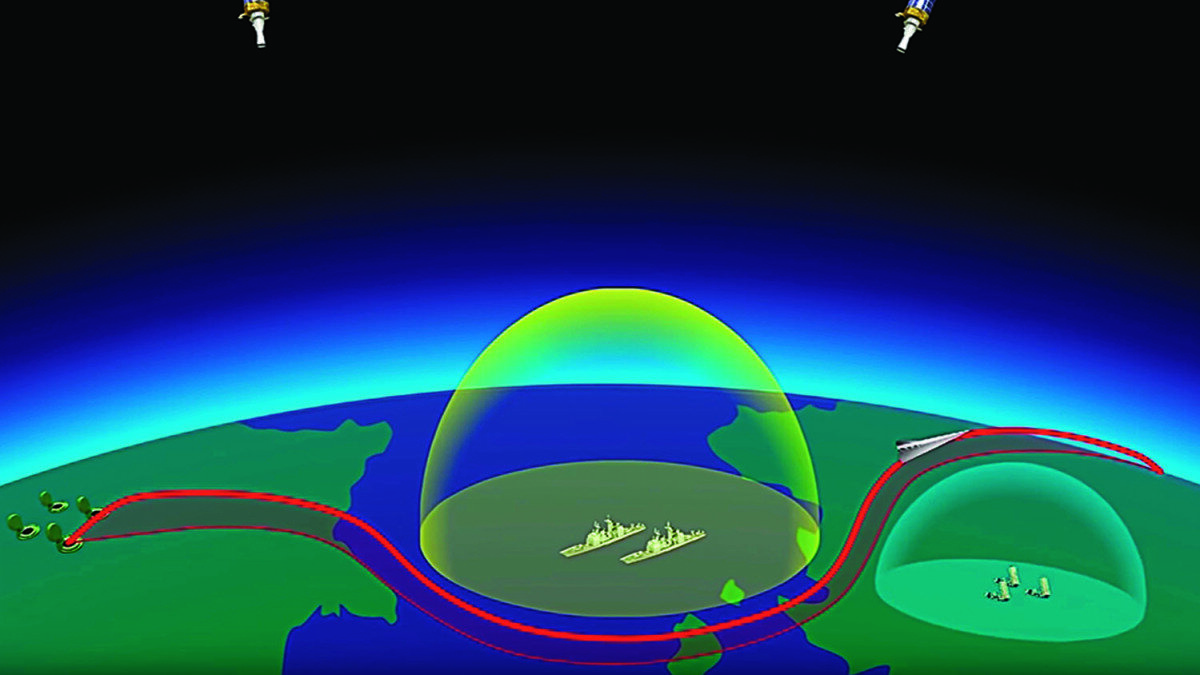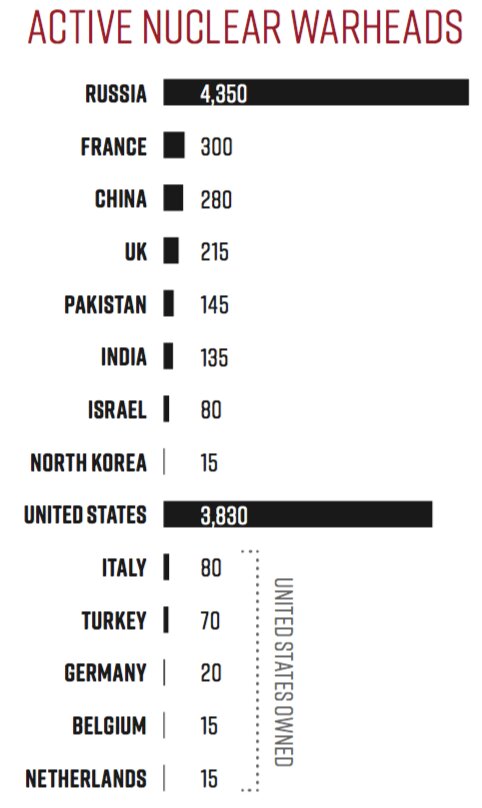Stocking Up for World War III
Since the United States and the Soviet Union backed away from the precipice of nuclear war in the 1980s, the world’s stocks of nuclear weapons have declined from an estimated 60,000 to an estimated 10,000.
According to a 2014 study by science journal Earth’s Future, however, it would take just 100 nuclear detonations to create a worldwide climate catastrophe causing massive famine and death.
Though the number of nukes is not (yet) rising, experts are saying that the world is in fact entering a new nuclear arms race. The race is moving ahead in ways other than sheer number of weapons. Around the world, new powers are considering launching nuclear weapons programs. For many of them, nukes have been taboo for decades—but that taboo is eroding.
Meanwhile, the established nuclear powers are racing to improve the quality of weapons and delivery systems—making them faster, stealthier and harder to shoot down.
Each new weapon that is manufactured has the potential to kill multitudes of people in an instant, and more in the aftermath. And each new regime or group that joins the club of nuclear-armed entities makes the likelihood of a detonation—or a string of detonations—more probable.
Russian Roulette
Russia has the largest nuclear arsenal in the world. Its government also boasts about its nuclear weapons more than perhaps any other, using its existing and developing nuclear weapons systems to intimidate others.

It has deployed nuclear-capable missiles in Kaliningrad, on the border of Poland and Lithuania. It has threatened East European countries, saying that if they host United States military bases, Russia will target them for possible nuclear destruction. It has even carried out simulated nuclear strikes on Poland as part of a training exercise.
For several years now, Russia has been updating its missiles. And President Vladimir Putin recently announced several new weapons. Russia’s new RS-28 Sarmat (popularly called the “Satan 2”) is the largest superheavy intercontinental ballistic missile in history. Each missile can carry 10 large nuclear warheads or 16 smaller ones, enough destructive power to practically destroy an entire European nation or an American state as large as Texas.

But the high point for Russian nuclear intimidation came on March 1 of this year. “Russia still has the greatest nuclear potential in the world, but nobody listened to us,” warned Putin in what amounted to a weapons presentation to the world. “Listen now.”
He went on to announce a series of terrifying new weapons.
He claims that Russia has developed an “invincible” missile, a “fundamentally new type of weapon”—a nuclear-powered cruise missile that flies too low to be intercepted by any existing missile defense system.

He also announced a nuclear-powered torpedo—perhaps another attempt to ensure that Russia can circumvent America’s nuclear defenses. The Russian press reported that it carries a 100-megaton warhead, which would release a devastating amount of radiation. “A single Russian submarine armed with these weapons would release more radiation than the entire U.S. strategic force,” wrote Mark Schneider for Real Clear Defense (May 7). The project seems similar to one proposed in the 1960s. Back then, the Soviets squashed it because the admiral in charge was “shocked and disgusted by the idea of merciless mass slaughter,” according to the weapon’s designer, Andrei Sakharov. But Putin’s Russia is pushing forward with it.
Of course, Putin is not well known for his honesty, and taking his claims for granted would be foolish. But so too would be underestimating a nuclear-armed adversary that is publicly displaying renewed interest in weapons that can penetrate the defenses of the United States and its allies. Putin’s March 1 presentation explicitly depicted a nuclear strike on Florida.
“Not everyone is sure that Russia is really this far along in developing a nuclear-powered cruise missile,” wrote Ars Technica. “But there’s plenty of evidence that they’re trying hard” (March 22). Some of these higher-profile projects may be questionable. But Russia is also pouring money into much more basic yet terrifyingly deadly nuclear upgrades.
Chinese Checkers
China is improving its nuclear arsenal as well. The U.S., China and Russia are all involved in an arms race to develop the next generation of nuclear missiles: hypersonic vehicles.
Intercontinental ballistic missiles have existed since the 1950s: They launch into space before returning into the atmosphere and speeding toward their targets. They’re fast, but for most of their flight, they cannot be maneuvered. So you can see them coming, you can calculate where they will land, you have time to react, and you have a chance to shoot them down.
Still, shooting down one missile using another missile is much harder than most people realize. Even the U.S. military is not very good at it right now.
But a hypersonic vehicle can travel low and fast—three times faster than the world’s fastest bullet. And it can be maneuvered. No missile defense system in existence today can stop one. U.S. Air Force Gen. John Hyten told the Senate Armed Services Committee in March, “We don’t have any defense that could deny the employment of such a weapon against us.”

In August, China claimed to have successfully tested two hypersonic missiles capable of carrying a nuclear weapon. Western experts believe Russia has carried out two successful tests of a hypersonic missile. cnbc claimed on May 15 that “sources with direct knowledge of American intelligence reports” said that Russia’s hypersonic weapon would be ready by 2020, though others dispute this.
America’s hypersonic program is very secretive. But some experts worry that America is running behind. The Pentagon told Congress earlier this year that China had carried out 20 times more hypersonic test flights than America.
Just like Russia, China is also working on its arsenal in less sensational but quite deadly ways. It is building six or seven warheads a year. Since September 2014, it has carried out an average of five simulated nuclear blasts a month, compared with America’s pace of just one a month. China may also be working on a “salted” nuclear bomb—a weapon designed to spread radiation as far as possible, rendering huge areas uninhabitable long after the blast. It is also working on new land-based launchers and new nuclear submarines.
Wild Cards
Other countries that do not yet have operational nuclear weapons are increasingly desirous of getting them. The weapons program of Iran, the world’s number one state sponsor of terrorism, is one of the most worrying. Despite (or perhaps even helped by) the quickly dying nuclear deal, the Iranians are still making progress toward a bomb. In June, they announced that they had nearly finished a new factory to make centrifuges. This will enable them to push toward a bomb more quickly.
This ambition is naturally making others nervous. In response, Saudi Arabia is working on its own nuclear-power plants. The International Atomic Energy Agency completed a 12-day review of the Saudis’ nuclear infrastructure development in July. Ostensibly it is intended for peaceful nuclear energy, but Saudi Crown Prince Mohammed bin Salman told cbs in March that “without a doubt if Iran developed a nuclear bomb, we will follow suit as soon as possible.”
New Players Enter the Game
Perhaps most remarkable is news from Germany and Japan—two nations that launched World War ii and that have a taboo about developing nuclear bombs. Welt am Sonntag, one of Germany’s top newspapers, asked on its front page on July 29, “Do We Need the Bomb?”
“National defense on the basis of a nuclear deterrent must be given priority in light of new trans-Atlantic uncertainties and potential confrontations,” wrote Christian Hacke.
Politico noted, “It would be easier to dismiss the article as the ramblings of an eccentric academic were Hacke not a fixture of Germany’s foreign-policy establishment and a respected university professor. That the debate is happening at all speaks to how unnerved Germany’s security community has become in the face of [U.S. President Donald] Trump’s threats, including his warning at last month’s nato summit that the U.S. might ‘go it alone’” (August 3).
Hacke is not alone. Frankfurter Allgemeine Zeitung, Spiegel Online, Tagesspiegel and public television channel ard have called for Germany either to develop nuclear weapons or to at least open up a debate on the matter. This talking point is becoming increasingly common among defense experts.
As Politico pointed out, perhaps the most likely course for Germany is to push for some kind of shared European nuclear arsenal. But it is vital to remember that Germany already has access to nuclear bombs: American ones. They are deployed on German bases, compatible with German aircraft, and ready for German pilots to drop.
Japan is having a similar debate. The Japanese have built one of the world’s most advanced nuclear-powered industries. They have the know-how and material to go nuclear but have chosen not to, so far. Channel News Asia reported in July that Japan has stockpiled enough plutonium for 6,000 atomic bombs.
“Japan appears to be caught up in the idea that in an emergency it can produce nuclear weapons with its reprocessing technology,” said Hideyuki Ban, codirector of the Citizens’ Nuclear Information Center in Tokyo. He may be right. Last year, former Japanese Defense Minister Shigeru Ishiba said Japan should abolish its “three non-nuclear principles”: not owning, not making and not hosting nuclear weapons in Japan.
And we cannot leave out the U.S. America is considering a $1 trillion upgrade to its nuclear arsenal, which already exceeds 4,000 operational warheads.
Why Worry?
The nuclear arms race is on. But why should you care?
First, a nuclear arms race is a symptom. Nations don’t spend billions on nukes merely for fun. They buy them because they want to threaten other nations or because they feel threatened. A nuclear arms race shows that nations are worried about war, or they desire to use the threat of war.
We are entering a time when new technologies may convince nations that they can use nukes and get away with it. At the same time, nations that have never been trusted with nuclear weapons are building them, or thinking about it. And as nuclear weapons spread to more countries, the risk rises that they will be used.
“The issue of nuclear arms control is a literally vital issue, not only for the superpowers, not only for their allies, but for all of humanity,” Hans Morgenthau, a top thinker in the field of international relations, wrote in his classic 1948 book Politics Among Nations. “For with proliferation now underway in earnest, there is little doubt that a nuclear arms race—no longer limited to two superpowers with cautious governments that are mortally afraid of each other—but spreading over the whole globe, is bound, sooner or later, to lead to an unspeakable catastrophe. For history shows, if history shows anything, that all nations have been governed at times by fools and knaves, and even a combination of both. That was bad enough before nuclear weapons existed. But imagine a fool or knave or a combination of both in the possession of nuclear weapons, and nuclear war becomes unavoidable.” This, Morgenthau concluded, “makes nuclear arms control and, in the end, nuclear disarmament a question of life or death for all mankind.”
Nuclear weapons are a problem we don’t like to think about because we have no solutions. In the 73 years since the first two nuclear attacks on Hiroshima and Nagasaki, no one has devised a way to eliminate nuclear weapons.
There is no hope for a solution from man’s foreign-policy elite. But there is hope in the Bible, along with some sobering warnings.
The Bible contains many prophetic passages that describe the aftereffects of nuclear bombs. Jeremiah 2:15 mentions cities “burned without inhabitant.” Habakkuk 3:17 describes plants that do not blossom or give fruit, fields that produce no food, and stocks of animals wiped out. Verse 16 tells us this is the work of soldiers—not a natural catastrophe. Amos 5:3 describes an attack destroying 99 percent of a city’s population!
Matthew 24:21-22 state, “For then shall be great tribulation, such as was not since the beginning of the world to this time, no, nor ever shall be. And except those days should be shortened, there should no flesh be saved …”—that the Moffatt version clarifies that this means “saved alive.” This isn’t about being saved spiritually or being saved from suffering. The context makes it clear that no flesh would be saved from dying. It is a prophecy of mankind nearly wiping itself out.
The Bible is clear: Nuclear weapons will be used. Vast populations will be killed.
But the same scriptures contain great hope. Verse 22 in Matthew 24 finishes by stating, “but for the elect’s sake those days shall be shortened.” God won’t allow mankind to destroy itself completely. Each prophet who forecast this destruction also described man’s great hope. Amos 9 describes Israel rebuilding the cities destroyed in war. In fact, the people have so much abundance, they cannot gather all the food in fast enough (verse 13). Jeremiah says that despite all the trouble, “there is hope in thine end” (Jeremiah 31:17). “[T]hey shall all know me, from the least of them unto the greatest of them, saith the Lord …” (verse 34). Habakkuk writes of a time when “the earth shall be filled with the knowledge of the glory of the Lord, as the waters cover the sea” (Habakkuk 2:14).
This is the only hope in the face of nuclear proliferation. The world’s best experts know that these weapons will be used. But God says that He will not allow mankind to annihilate itself. Instead, the suffering caused as mankind brings itself within inches of its own destruction will finally make human beings willing to listen to God. God will intervene and will finally be able to teach the world and lead all man in the way of real peace.
This is why it is so crucial to closely watch the development and proliferation of nuclear weapons. It is frightful, but it is also intimately connected with man’s only hope.
